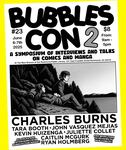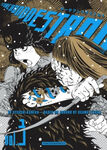

This massive hardcover volume is now the definitve account of the life and work of the one and only Harvey Kurtzman, the man who brought the world Mad and so much more. Written by Kurtzman's friend and one-time publisher, Denis Kitchen, who also currently represents the Kurtzman estate, in collaboration with the prolific cultural historian and biographer, Paul Buhle. Kitchen is an accomplished cartoonist in his own right, one who was influenced by Kurtzman, and who was active during the glory days of Underground comix, and so is more fully capable of appreciating Kurtzman's achievement than your average biographer. This book has it all: miraculously preserved childhood drawings, early comics and illustration work, Kurtzman's glory days in comics, the creation of Mad, Humbug, Trump, and Help! followed by Little Annie Fannie and much, much more, including plenty of rarities that will astound and delight Kurtzman fans. And now available for an amazing price! What's not to like?

Published by one of the leading lights of the Left, Verso Books, this anthology is jam-packed full of engaging, entertaining, enjoyable and, especially, educational comics about a wide swath of historical figures – ranging from Walt Whitman to Charlie Parker and including Gertrude Stein, Mabel Dodge, Billie Holiday, Josephine Baker and far too many others to mention here – that have been collected together under the umbrella of "Bohemians." There are some great comics on hand here, by the likes of Sharon Rudahl, Dan Steffan, Sabrina Jones, Matt Howarth, Lance Tooks, David Lasky, Milton Knight, Ellen Lindner, Peter Kuper, Afua Richardson, and the late, great Spain Rodriguez, whose participation here indicates that this has been a long fermenting project. All in all it makes for a great read, and it's a good deal! Laugh and learn, for less. Recommended.

Black Coal & Red Bandanas: An Illustrated History of the West Virginia Mine Wars dramatizes in comics form a series of related instances of the intense violence that can be inspired by the struggle for control over energy resources – in this case, coal – and that took place in West Virginia – not far from us here in Pittsburgh, PA – early in the twentieth century. As it is up to our very day, the demand for control of energy resources comes from the holders of capital, as energy is the principle bedrock of the control of the systems that undergird the global capitalistic framework – at least since the dawn of the industrial era. When challenges to the control of energy rescouces emerge, the responses on the part of the "owners", are often harshly punitive. And, as shown through the progression of the four incidents recorded here, can easily escalate, leading to explosive violence. The challenges to control – here, that of coal extraction – come in the form of both organized labor and individual miners – with a particular focus on the figure of labor agitator, "Mother Jones".
The forces at work are both simple and complex. Simple in that these "mine wars" were fought between capital and labor, complex in the actual ways in which the opposing sides organized and marshalled their respective forces and engagements with government officials and written law.
It should be noted that this work, in delivering its sober message, records the extreme violence with which the labor resistance was met – and the impunity with which is was meted out by the mine owners and their agents, who acted with seemingly no fear of repercussions to themselves or their businesses. As such, it may not be appropriate for younger and/or sensitive readers. Regardless, such readers should proceed with caution.
The author, Raymond Tyler, had his work cut out for him, as there is a tremendous amount of material – often involving conflicting reports of the facts on the ground – that needed to be both sorted through and then compressed into a story that could be conveyed in graphic novel form. A notable effort was made to bring to the fore the intersectionality of the labor struggle, with the acknowledgement that approximately one in four miners were Black at the same time that the United Mine Workers union (UMW) excluded Blacks from membership. This did not stop the Black mine workers from joining the fight against the depredations of capital.
The artist, Summer McClinton clearly put a great effort into researching the people and places – as well as the historical epoch – (likely also studying the John Sayles film, Matewan for its dramatic effects in addition to other historical materials) and so effectively presents the action in a "you are there" fashion. Her artwork is especially effective in capturing the persona of "Mother Jones" and how it subtley shifted as she aged over the twenty-year period which is covered here. As mentioned above, the artwork does not shy away from depicting the violence that these strikes engendered – they are referred to as "wars" with good reason – but neither does it sensationalize or glorify the violence, quite the contrary. McClinton's art characterizes the violence as brutish senselessness. We posted a few pages from the book on the Copacetic Tumblr, HERE so you can get an idea.
The 100 page comics dramatization at the core of this book divides the mine wars of the title into four battles, each of which is given their own chapter, and is bracketed by contextualizing essays by Gordon Simmons and Shaun Slifer at the fore and Paul Buhle at the aft. There are references to many supporting works of the history of these battles – as well as to the West Virginia Mine Wars Museum – for anyone interested in digging deeper.
This book has been produced in affiliation with Working Class History, "an international collective of worker-activists focused on the research and promotion of people's history."
A potential holiday gift for the class conscious labor supporter on your list.
EARLY BIRD SPECIAL PRICE!










